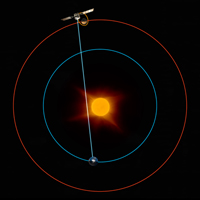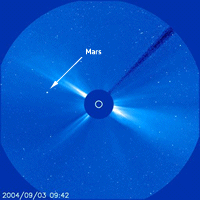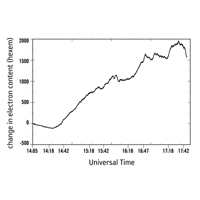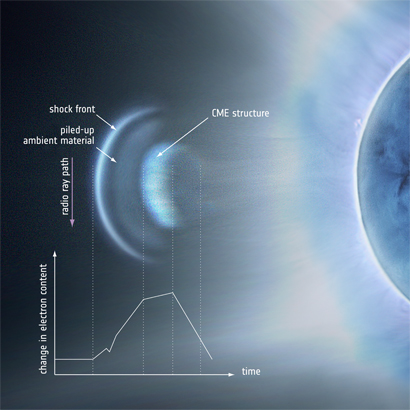Planetary missions probe giant eruptions in the Sun's corona
24 July 2012
Scientists have probed the corona of the Sun by studying the disturbances that it causes to radio transmission from three of ESA's planetary missions: Mars Express, Venus Express and Rosetta. The measurements were performed on several occasions, when each of the spacecraft was located behind the Sun as viewed from Earth. In particular, five coronal mass ejections were detected with Mars Express in 2004. Analysis of these data has revealed the morphology of these colossal solar eruptions in great detail, complementing the view that can be achieved via direct imaging of the Sun's corona.
 |
|
Radio sounding of the solar corona with Mars Express. Credit: ESA/AOES Medialab |
The spacecraft that explore planets and other bodies in the Solar System use radio signals to regularly communicate with ground-based antennas – an essential tool for scientists on Earth to both operate the spacecraft and receive the data that they collect. In addition, the radio signals used for these transmissions can also be exploited to perform additional measurements that increase the scientific return of the missions. Using a variety of techniques, radio-science experiments have allowed scientists to probe otherwise hidden aspects of the atmosphere, surface and gravitational field of a number of planets and other Solar System bodies over the past few decades.
On rare occasions, radio science can also be employed to study the solar environment. This is possible when spacecraft are in a particular position, referred to as superior solar conjunction, when Earth, Sun and the spacecraft lie on the same line with the spacecraft located on the opposite side of the Sun with respect to our planet. In this configuration, or more precisely just before and after it, radio signals sent out by the spacecraft pass through the solar corona – the hot outer atmosphere of the Sun, which consists of turbulent plasma with temperatures of millions of degrees – as they travel towards Earth. Electrons in the coronal plasma interact with the radio signals, causing a frequency shift that can be measured on Earth and analysed to infer the electron density in the corona.
 |
|
A series of images of the Sun's corona as traversed by a coronal mass ejection, obtained with SOHO/LASCO on 3 September 2004. Credit: SOHO/LASCO (ESA & NASA) |
Radio sounding of the solar corona has been performed with a number of spacecraft over the past few decades. This technique is complementary to direct imaging of the corona in visible light, which can be accomplished using a coronagraph to block light coming directly from the Sun's surface. Radio-sounding experiments can only look at the corona along one line of sight at a time, as opposed to the wide-field view provided by coronagraph images. However, as the spacecraft slowly moves across the plane of the sky, the radio signals that it transmits travel along different paths through the corona; this allows scientists to probe how its electron density declines at increasing distances from the Sun. In addition, measurements are recorded every second and thus result in monitoring of the corona at very high temporal resolution.
A new study, led by Martin Pätzold from the Rheinisches Institut für Umweltforschung in Cologne, Germany, has combined radio sounding data from three of ESA's Solar System missions: Mars Express, Venus Express and Rosetta. The team of scientists have taken advantage of the solar conjunction of these spacecraft on various occasions – in 2004, 2006 and 2008 for Mars Express, and in 2006 for Rosetta and Venus Express. The results are reported in the journal Solar Physics.
"The radio sounding campaigns performed with Mars Express, Venus Express and Rosetta span the declining phase of a solar cycle towards its minimum, which occurred in December 2008," explains Pätzold. From a joint analysis of all the data, the scientists have derived a radial profile for the density of electrons in the corona. This profile agrees well with similar measurements performed with the ESA/NASA Ulysses mission in the early 1990s by the same team of scientists. "Interestingly, the electron density in the low-latitude solar corona does not vary significantly across a solar cycle, nor does it change greatly from one cycle to the next," he notes.
 |
|
Variations in the electron density of the Sun's corona during the CME occurred on 3 September 2004, as probed via radio sounding with Mars Express. Image courtesy of Martin Pätzold. |
Chances to observe more spectacular phenomena such as Coronal Mass Ejections (CMEs) depend strongly on the phase of the solar cycle during which measurements are performed. CMEs are gigantic eruptions that release enormous amounts of matter and energy from the Sun through the corona and into space, and are most frequent when the Sun's activity is at its peak. These dramatic bursts leave a distinctive signature in the data recorded via radio sounding – a sudden increase in the noise pattern of the radio signal.
"We have identified five CMEs in the Mars Express radio sounding data from 2004," says Pätzold. In the case of four of them, coronagraph images from the Large Angle and Spectrometric Coronagraph (LASCO) instrument on board the ESA/NASA SOHO mission were also available, confirming the presence of the CMEs detected in the radio data and revealing their entire spatial extent. "The five CMEs detected in the Mars Express data have allowed us to determine the morphology of these colossal eruptions in great detail by studying how the electron density along the radio signal path varies as the CME crosses it," he adds.
According to the data, when the path of the radio signal is traversed by a CME, the electron density first undergoes a gentle rise, followed by a steeper increase and, eventually, by a smooth decline. "This suggests that the proper, dense structure of a CME is preceded by a shock front and a series of smaller fronts that consist of less dense material," explains co-author Michael Bird from the University of Bonn, Germany. The structure that precedes the main body of a CME and is responsible for the initial, gentle rise in density, builds up as the CME itself propagates outward through the corona, pushing material ahead of it and piling it up in a similar way to a bulldozer. In contrast, material immediately behind the CME has extremely low density, as indicated by the eventual density decrease.
 |
| The morphology of a coronal mass ejection as revealed by radio-sounding experiments. Credit: ESA/AOES Medialab |
"Radio sounding of the Sun's corona is among the few experiments that can be performed when a spacecraft is in superior solar conjunction," comments Olivier Witasse, Mars Express Project Scientist. In fact, the presence of the Sun along the path to Earth represents a major nuisance to the transmission of data acquired locally by the spacecraft, hence a mission's scientific programme is substantially reduced during this phase. "It is exciting to see planetary missions being successfully exploited even when their orbital configuration is not the most favourable, and how data gathered on such occasions may increase our knowledge about the physics of the Sun," he concludes.
Notes for editors
The study presented here is based on radio sounding experiments of the solar corona performed with the Mars Radio Science (MaRS) instrument on board Mars Express, the Venus Radio Science (VeRa) instrument on board Venus Express and the Radio Science Investigation (RSI) instrument on board Rosetta. The measurements were performed during the superior solar conjunctions of Mars Express in August to October 2004, October and November 2006 and November 2008 to January 2009, of Rosetta in March to May 2006, and of Venus Express in October to December 2006.
Five Coronal Mass Ejections (CMEs) were detected in the 2004 data from Mars Express. No CMEs were found in the data gathered by any of the three spacecraft in 2006 and 2008. Comparison with coronagraph images from the Large Angle and Spectrometric Coronagraph (LASCO) instrument on board the ESA/NASA SOHO mission shows that a number of CMEs did occur during the radio-sounding campaigns in 2006, but unfortunately on the opposite limb of the Sun to the one where the spacecraft were located. No CMEs occurred during the conjunction of Mars Express in 2008.
In addition, a substantially higher density of electrons was recorded for a few days during the 2006 conjunction of Rosetta. By inspecting SOHO/LASCO images from the same time span, the scientists could link the enhanced density to the occurrence of a helmet streamer. A helmet streamer is a dense and bright, elongated structure extending above an active region on the Sun's surface. While rotating along with the Sun, this particular helmet streamer crossed the radio signal path from Rosetta for about a week.
Related publications
M. Pätzold, et al., "Coronal Density Structures and CMEs: Superior Solar Conjunctions of Mars Express, Venus Express, and Rosetta: 2004, 2006, and 2008", 2012, Solar Physics, Volume 279, Number 1, Pages 127-152. DOI: 10.1007/s11207-012-9991-y
Contacts
Martin Pätzold
Rheinisches Institut für Umweltforschung, Abt. Planetenforschung
Cologne, Germany
Email: Martin.Paetzold![]() uni-koeln.de
uni-koeln.de
Phone: +49-221-27781810
Michael K. Bird
Argelander-Institut für Astronomie
Universität Bonn
Germany
Email: mbird![]() astro.uni-bonn.de
astro.uni-bonn.de
Phone: +49-228-731771
Olivier Witasse
Mars Express Project Scientist
Research and Scientific Support Department
Directorate of Science & Robotic Exploration
ESA-ESTEC, The Netherlands
Email: Olivier.Witasse![]() esa.int
esa.int
Phone: +31-71-5658015

